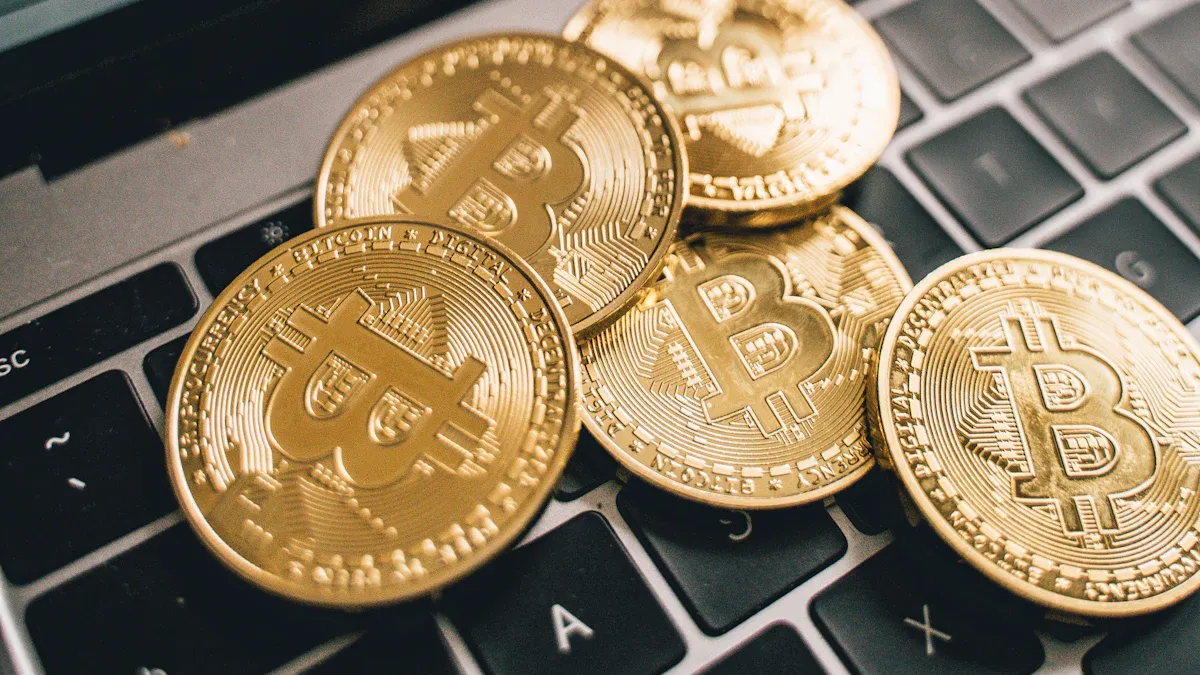What Makes the Most Expensive Cryptocurrency Valuable
2025-05-21 08:28:56
The value of the most expensive cryptocurrency stems from several unique factors that set it apart. Bitcoin, for instance, owes much of its high price to its capped supply of 21 million coins. This scarcity drives demand, especially during times of heightened interest. Predictability plays a role too. Fixed supply ensures investors know the asset won’t dilute over time, boosting confidence. Additionally, when a cryptocurrency links its issuance to real utility or growth, it rewards stakeholders without undermining its value. These elements combine to create a powerful mix of utility, market demand, and investor trust.
Key Takeaways
- Limited supply increases value. Bitcoin has only 21 million coins, making it rare and wanted by investors.
- Usefulness adds worth. Cryptocurrencies like Bitcoin help solve real-world problems, making them useful for buying and selling.
- More users raise value. When more people use a cryptocurrency, its usefulness and price grow.
- News affects prices. Good news makes people want to buy, but bad news can lower its value.
- Clear rules build trust. When governments make clear laws, cryptocurrencies seem safer, attracting more buyers.
Core Value Drivers of the Most Expensive Cryptocurrency

Utility and Real-World Applications
The most expensive cryptocurrency derives much of its value from its utility and ability to solve real-world problems. Bitcoin, for example, functions as a decentralized currency, allowing users to transfer money globally without intermediaries. Its divisibility makes it practical for transactions of any size, enhancing its usability as a medium of exchange. Cryptocurrencies also enable tokenization, which transforms traditional assets into digital ones. This process improves accessibility, transparency, and efficiency, making these assets easier to trade on crypto exchanges. As tokenized assets gain traction, they blur the lines between digital and traditional markets, further boosting their value.
Moreover, the integration of tokenized assets into exchanges offers tangible benefits. Faster settlement times, lower transaction costs, and fractional ownership attract more users, increasing demand. As adoption grows, the utility of cryptocurrencies expands, reinforcing their position as a store of value and driving their price higher.
Scarcity and Limited Supply
Scarcity plays a pivotal role in the valuation of the most expensive cryptocurrency. Bitcoin’s capped supply of 21 million coins ensures that its availability remains limited, creating a sense of exclusivity. This scarcity drives demand, especially among investors seeking assets with predictable supply dynamics. The Stock-to-Flow (S2F) model highlights Bitcoin’s scarcity by comparing its current supply to its annual production. With a current supply of 19.71 million and an annual production of 164,250, Bitcoin’s S2F ratio stands at 120. This ratio surpasses that of gold and silver, making Bitcoin an even scarcer asset.
Scarcity also influences investor behavior. As the supply diminishes over time, the perception of Bitcoin as a valuable store of value strengthens. Investors view it as a hedge against inflation and a reliable alternative to traditional money. This perception amplifies demand, pushing its price higher and solidifying its status as the most expensive cryptocurrency.
Adoption and Network Effects
Adoption is another critical factor driving the value of cryptocurrencies. As more users join a network, its utility and market value increase. Bitcoin’s widespread adoption as a digital currency has made it a household name, attracting both retail and institutional investors. Network effects amplify this growth. When more people use Bitcoin, its liquidity improves, making it easier to trade and exchange.
Other cryptocurrencies, like Solana, demonstrate how adoption impacts valuation. Solana’s Total Value Locked (TVL) reached $10.9 billion, surpassing Ethereum’s layer-2 ecosystem. Increased staking activity, with 65% of SOL supply locked, reduces liquidity and creates upward pressure on its price. Revenue from network fees also surged, indicating growing usage and demand. These factors show how adoption drives value, making cryptocurrencies more appealing to investors seeking high returns.
Market Dynamics Behind Cryptocurrency Price
Supply and Demand
The fundamental principle of supply and demand plays a significant role in determining the value of the most expensive cryptocurrency. When the supply of a cryptocurrency is limited, as in the case of bitcoin, its scarcity creates a sense of exclusivity. This limited supply often leads to increased demand, especially during periods of heightened interest. For instance, bitcoin’s capped supply of 21 million coins ensures that it remains a scarce asset, which strengthens its position as a store of value.
Demand for cryptocurrencies also rises when they offer unique features or solve real-world problems. As more people adopt these digital assets, their utility increases, driving up their price. On the other hand, when demand decreases or supply increases, prices tend to fall. This delicate balance between supply and demand creates the dynamic nature of cryptocurrency markets, where prices can fluctuate rapidly based on market conditions.
Speculation and Investor Behavior
Speculation is another key driver of cryptocurrency price volatility. Many investors are drawn to the potential for high returns, especially during market downturns. For example:
- During bearish market conditions, investors often focus on early-stage cryptocurrency projects, hoping to capitalize on their growth potential.
- The presale of Lightchain AI, which speculated a 43,120% return on investment, highlights the trend of speculative investments in new projects.
Bitcoin’s price history also demonstrates how speculative behavior influences its value. In Q1 2025, bitcoin experienced dramatic price swings, reaching a peak of nearly $109,000 before a sharp correction. These fluctuations were driven by macroeconomic uncertainties and regulatory developments. Such events show how investor sentiment and speculative actions can lead to significant price changes.
Interestingly, cryptocurrencies often show resilience even during broader market declines. Bitcoin, for instance, formed a double-bottom pattern during a downturn, signaling institutional accumulation. This behavior suggests that investors remain optimistic about its long-term value, even in challenging market conditions.
Market Sentiment and Perception
Market sentiment and public perception have a profound impact on cryptocurrency prices. Positive sentiment can drive demand and push prices higher, while negative sentiment can have the opposite effect. Media coverage and influential figures often shape this sentiment. A notable example occurred when Elon Musk added the bitcoin hashtag to his Twitter biography. Within hours, bitcoin’s price surged from $32,000 to $38,000, demonstrating the power of public perception.
Search trends also reveal how sentiment influences cryptocurrency markets. Data shows a strong correlation between Google search interest and bitcoin’s price and trading volume. As search interest increases, both price and volume tend to rise. This pattern highlights how public awareness and curiosity can drive demand, further influencing the value of cryptocurrencies.
Technological and Network Factors in Cryptocurrency Value

Blockchain Innovation and Features
Blockchain technology forms the backbone of the most expensive cryptocurrency. Its innovative features, like immutability and transparency, make it a game-changer in the financial world. Bitcoin, for instance, uses a decentralized ledger to record transactions, ensuring no single entity controls the network. This transparency builds trust among users and enhances its value as a store of value.
Performance metrics also help measure how effective a cryptocurrency network is. For example:
| Metric | Description |
|---|---|
| Sharpe Ratio | Measures excess return per unit of risk, useful for comparing risk-adjusted performance. |
| Jensen’s Alpha | Assesses portfolio performance relative to expected return, isolating managerial skill from market movements. |
These metrics allow investors to evaluate the network's efficiency and potential returns, further driving demand and adoption.
Security and Decentralization
Security and decentralization are critical to a cryptocurrency's value. Bitcoin excels in this area by using a proof-of-work mechanism, which makes it highly resistant to attacks. Decentralization ensures no single point of failure, increasing user confidence. Studies have shown that communities like r/bitcoin trust technology over individuals, reinforcing the importance of decentralization.
However, challenges remain. Collaborative mining can lead to centralization risks, as dishonest administrators may exploit the system. Major exchanges like Coinbase and Binance also control user funds, which contradicts the decentralized ethos. Despite these issues, Bitcoin's robust security framework continues to attract investors, cementing its position as a reliable asset.
Scalability and Transaction Speed
Scalability and transaction speed significantly impact a cryptocurrency's usability and value. Bitcoin processes around seven transactions per second, which limits its scalability compared to newer blockchains. However, solutions like the Lightning Network aim to address this issue by enabling faster and cheaper transactions.
Other cryptocurrencies, like Solana, have gained attention for their high throughput and low fees. These features make them attractive for everyday use as a currency. Faster transaction speeds also improve user experience on exchanges, boosting demand and adoption. As scalability improves, cryptocurrencies become more practical for global money transfers, enhancing their value and appeal.
External Influences on Cryptocurrency Price
Regulatory Developments
Regulatory changes play a significant role in shaping the value of cryptocurrencies like bitcoin. When governments introduce clear guidelines, it often boosts investor confidence and legitimizes the market. For instance, the approval of Bitcoin ETFs has driven institutional interest, as evidenced by the surge in open interest for CME Bitcoin futures. Similarly, legalization efforts in the U.S. have enhanced bitcoin’s status as a legitimate currency, attracting more investors.
However, the crypto market remains highly sensitive to regulatory news. A single announcement can lead to significant price fluctuations. For example, stricter Anti-Money Laundering (AML) and Know Your Customer (KYC) regulations aim to curb illicit activities but can also impact trading volumes. Taxation policies, which classify digital assets as property or commodities, further influence how investors perceive cryptocurrencies as a store of value.
| Regulatory Change | Description |
|---|---|
| AML and KYC Regulations | Implementation of stringent regulations to deter money laundering and illicit activities. |
| Taxation Policies | Guidelines for treating digital assets as property, commodities, or currency for tax purposes. |
| Legislative Sandbox Approaches | Establishing controlled environments for innovation while monitoring systemic risks. |
Macroeconomic Trends
Macroeconomic factors also affect cryptocurrency prices. Inflation, for instance, often drives demand for bitcoin as a hedge against devalued money. Interest rates and geopolitical events, such as tariff announcements, further influence its value. Bitcoin’s price movements frequently align with traditional financial indicators like the S&P 500 and Nasdaq-100, highlighting its growing integration into global markets.
The relationship between bitcoin and government bond yields also underscores its sensitivity to macroeconomic trends. When yields fluctuate, bitcoin’s value often reacts in tandem, reflecting its dual role as a speculative asset and a store of value. These trends show how external economic forces shape the cryptocurrency market, making it essential for investors to monitor global developments closely.
- Key macroeconomic influences on bitcoin’s value:
- Inflation rates.
- Interest rates.
- Geopolitical events.
- Correlation with equity indices like the S&P 500.
- Government bond yield differentials.
Media Coverage and Public Awareness
Media coverage and public sentiment significantly impact cryptocurrency valuation. Positive news often drives demand, while negative coverage can lead to sharp declines. Social media platforms amplify this effect, as public reactions to market events spread rapidly. For example, when Elon Musk tweeted about bitcoin, its price surged within hours, showcasing the power of public awareness.
Search trends also reveal how curiosity influences demand. A spike in Google searches for bitcoin often correlates with increased trading volume and price movements. Analysts have found that both qualitative and quantitative assessments of public sentiment are critical for predicting cryptocurrency trends. As more people become aware of bitcoin’s potential as a currency and store of value, its adoption continues to grow, further enhancing its value.
- Key factors influencing public sentiment:
- Social media activity.
- Reactions to market events.
- Media analysis reports.
The value of cryptocurrencies like bitcoin comes from a mix of intrinsic and external factors. Scarcity, utility, and market dynamics all play a role in what drives the price of bitcoin. For example, its capped supply creates exclusivity, while its real-world applications add intrinsic value. External influences, such as regulations and media coverage, further shape its price.
Understanding these factors helps investors see why some cryptocurrencies hold higher value. It also highlights how innovation and adoption continue to drive demand. By examining these elements, readers can better grasp the complex forces behind cryptocurrency valuation.
FAQ
What makes Bitcoin more expensive than other cryptocurrencies?
Bitcoin’s capped supply of 21 million coins creates scarcity, which drives demand. Its first-mover advantage, widespread adoption, and robust security also contribute to its high value. These factors make Bitcoin a trusted store of value compared to other cryptocurrencies.
How does scarcity affect cryptocurrency prices?
Scarcity limits the supply of a cryptocurrency, making it more desirable. When demand exceeds supply, prices rise. Bitcoin’s fixed supply is a prime example, as its limited availability increases its appeal to investors seeking a hedge against inflation.
Why do cryptocurrency prices fluctuate so much?
Cryptocurrency prices change due to supply-demand dynamics, speculation, and market sentiment. News, regulations, and macroeconomic trends also play a role. These factors create volatility, making prices rise or fall quickly based on investor behavior and external events.
Can regulations impact the value of cryptocurrencies?
Yes, regulations can significantly influence cryptocurrency prices. Clear guidelines often boost investor confidence, while restrictive policies may reduce demand. For instance, Bitcoin ETFs and legalization efforts have positively impacted its value by attracting institutional investors.
How does media coverage affect cryptocurrency prices?
Media coverage shapes public perception and market sentiment. Positive news can drive demand and push prices higher, while negative reports may cause declines. Social media amplifies this effect, as influential figures and trending topics can quickly sway investor behavior.